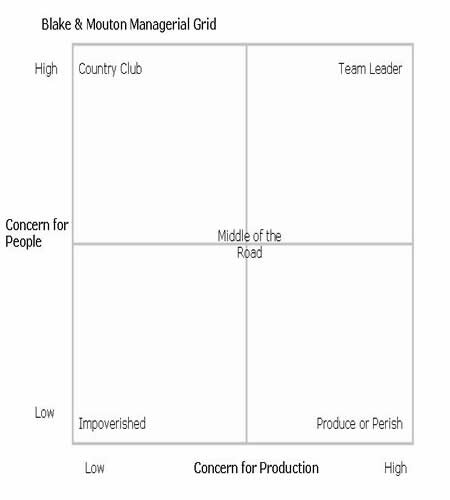Managerial Grid |
Robert Blake & Jane Mouton |
| Recommend this article to your friends! |
|
|
|
|
|
|
|
The managerial grid model (1964), developed by Robert Blake and Jane Mouton, is a behavioral leadership model. The model is an excellent way to map out different leadership styles, and an excellent way to evaluate the leadership performed by leaders and managers.
This model identifies five different leadership styles based on the concern for people and the concern for production. It is important to remember that none of the concerns are right or wrong, and the concerns are ideally balanced to the respective situational context of leadership. The model is graphically illustrated at the end of the article.
By charting the position in the grid it is possible to diagnose which leadership style is being performed, and to evaluate the appropriateness of the style of leadership. The five different leadership styles found in the managerial grid are presented below: Country Club Leadership - High Concern for People/Low Concern for Production Produce or Perish Leadership - High Concern for Production/Low Concern for People Impoverished Leadership - Low Concern for Production/ Low Concern for People Middle of the Road Leadership - Medium Concern for Production/Medium Concern for People Team Leadership - High Concern for Production/High Concern for People Use of the managerial grid Firstly, leaders should plot their own style into the managerial grid, and diagnose which leadership style they are conducting. Secondly, leaders can evaluate their leadership style, and assess if they could improve their leadership style in some way. Thirdly, leaders should put their leadership style into the respective situational context, and try to balance their leadership style to the needs found in the organization. The team leadership style may not be best in all situations, and some situations, like e.g. and economic crisis, might call for an entirely different style like e.g. a produce or perish leadership style. Leaders must therefore analyze which leadership style is called for, and afterwards analyze whether or not they conduct the most appropriate style. This analysis is therefore based on the different contingencies facing an organization, and leaders may use the knowledge from Contingency Theory or the PESTEL Framework to analyze which leadership styles are most appropriate for the viability of the organization. |
| Date Created: 2010-05-19 |
| Posted by: Admin |
 |
|
Related resources: |
| What is Theory X and Theory Y? Transformational vs. Transactional Leadership Max Weber’s three types of authority Kurt Lewin's Leadership Styles What is Paternalistic Leadership? What is the Situational Leadership Theory? |
| Reference(s) |
| The Managerial Grid: The Key to Leadership Excellence |
| Blake, R.; Mouton, J. (1964); Gulf Publishing Company |
| Keywords: |
Online MBA, Online MBA Courses, Blake, Mouton, Managerial Grid, Produce or perish, country club, middle of the road, Team Leader, Impoverished, Leadership Styles |
Copyright © BusinessMate 2009-2014
